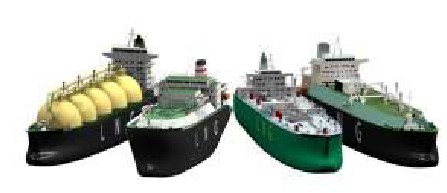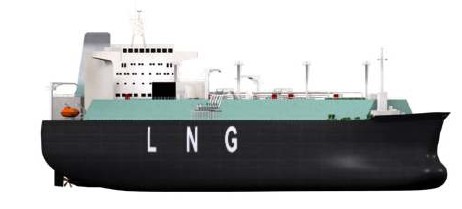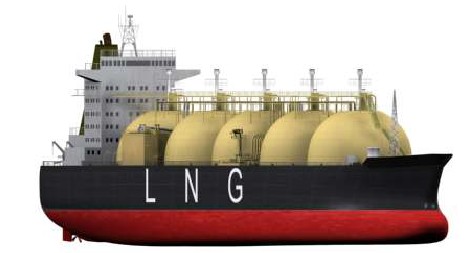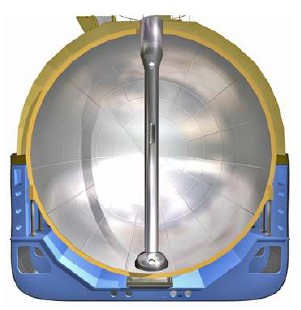- Carrying liquefied natural gases by various type LNG ships
( We have extracted gas carrier images and information from the publication ‘LNG Shipping Knowledge’ by Witherby Seamanship )
Liquefied Natural Gas (LNG) Carriers
LNG carriers in service are fitted with independent cargo tanks and with membrane tanks. LNG carriers are generally specialised ships transporting LNG at its atmospheric pressure boiling point of approximately -162 degree C, depending on the cargo grade. These ships are usually dedicated vessels, but some smaller examples may also carry basic LPG cargoes. If an LNG ship is capable of carrying basic LPG cargoes, a reliquefaction plant is installed to handle the boil-off LPG cargo vapours.
LNG carriers were typically in the range 80-135,000 m3 up until 2006. In 2006 the first LNG ships of over 200 and 250,000 m3 were being constructed for the new LNG trains being constructed in Qatar.
Temperature control
LNG is liquefied by refrigeration to -162°C and this process is carried out ashore, before the cargo is loaded onto the ship.
LNG carriers are fully insulated because it is not cost effective to liquefy methane onboard (2006, though the first vessels with reliquifaction plants may appear in the next few years). As the ship has no reliquifaction plant any boil-off vapours are burned as fuel gas in the the engine room.

Fig:Various type LNG carrier
Construction
The cargo containment systems will generally be either: LNG Carriers - Membrane systems (Gaz Transport / Technigaz) previously described. (A full secondary barrier with inerted spaces is required for the membrane system) This system has a primary and secondary barrier that is constructed of a thin material and an insulation layer. - Type B (Moss Rosenberg) (The Type B spherical tank requires only a partial secondary barrier) A full double-bottom and side tank ballast system is fitted to all LNG ships.

Fig:LNG carrier membrane gaz transport
Membrane (Gaz Transport or Tecnigaz)
There are two membrane systems in use. In both cases the insulation is fitted directly into the inner hull and the primary barrier consists of a thin metal membrane less than one millimetre thick.
The Gaz Transport system uses two such membranes constructed of ‘Invar’ (36% nickel-iron low expansion alloy). One acts as the primary barrier and the other the secondary barrier and they are separated by plywood boxes of perlite insulation. Similar boxes are fitted between the secondary barrier and the inner hull. Loading is transmitted through the insulation to the ship structure. No centreline division is possible in this type of tank. The other system, developed by Technigaz, has a stainless steel membrane as the primary barrier while the secondary barrier is included in the insulation, which consists of load bearing balsa and mineral woods.

Fig:LNG carrier moss tanks
Moss Tanks
Spherical tanks are generally produced in aluminium or 9% nickel steel. The sphere is welded to a steel skirt that is connected to the hull of the ship and is then free to expand and contract as necessary.
Insulation is fitted to the outside shell of the sphere but no secondary barrier is regarded as necessary across the upper part of the sphere. However, below the sphere, an aluminium drip tray, together with splash plates, provides secondary protection for the hull.
Fig:LNG carrier moss tanks cross section
Related Information:
- Carrying liquefied gases by fully pressurized ships
- Transport of bulk liquefied gases by semi pressurized ships
- Fully refrigerated ships for carrying liquefied gases
- Use of ethylene carriers
- LNG spill risk during marine transportation and hazards associated
- Increased Cargo Capacity for LNG ships & Advantages of the dual fuel diesel electric propulsion
External links :
Tuesday, August 2, 2011
Subscribe to:
Post Comments (Atom)


No comments:
Post a Comment